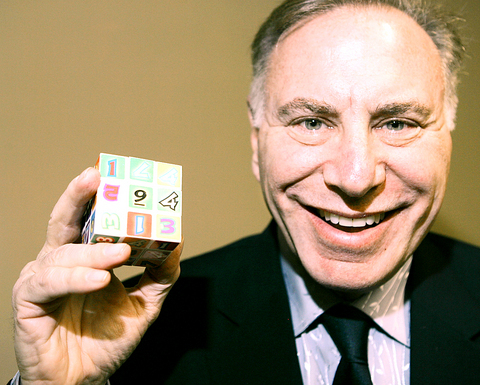A warehouse in middle-of-nowhere northeast Ohio has become the final resting site for hundreds of large metal molds once used to make some long-forgotten toys.
From time to time, toy industry veteran Jay Horowitz uses the molds he has accumulated to resurrect a toy and reintroduces it to the collectibles market, cashing in on its nostalgic value.
But last year, in what he calls a moment of inspiration, Horowitz merged a classic 1980s toy with a recent puzzle fad.

PHOTO: AP
He thinks he has got a major seller on his hands with the Sudoku Cube -- a blend of Sudoku and the Rubik's Cube.
Sudoku, the addictive puzzle craze that originated in Japan, is made up of number grids that require the numbers one through nine to be filled into squares arranged in rows of nine without repeating a number in any line. The Rubik's Cube is a block made of various colored, movable squares that the user tries to line up into solid colors on each side.
Horowitz was peddling his hybrid of Rubik's Cube and the popular puzzle Sudoku to a worldwide audience at the American International Toy Fair last week in New York City.
The Sudoku Cube sells for about US$10 and is more complicated than Rubik's Cube. Horowitz's cube challenges the player to align numbers one through nine on one or more sides or in rows.
The colorful cube is made in China by his newly formed company, American Classic Toy Inc. Retailers carrying the cube include Barnes & Noble, FAO Schwarz and backtobasicstoys.com.
Horowitz has already sold thousands, but he has some competition. There are several other Sudoku cubes on the market. A search on Amazon.com shows two other versions, named Sudokube.
Sudoku fans who feel like they have mastered the paper version -- the puzzle found in most daily newspapers -- have shown interest in the cubed versions, said Adrienne Citrin, spokeswoman for the Toy Industry Association.
"We're seeing that Sudoku and the next phase of brain teasers are becoming increasingly popular," Citrin said. "These cubes are the next level."
Even in an age of video games, Citrin said puzzle games are experiencing a surge of popularity.
"People feel a sense of accomplishment when they've completed the puzzle or the game. We see this as an increasing trend," Citrin said.
The 60-year-old Horowitz has spent years reproducing classic toys like Gaylord the Pup, Howdy Doody and Evel Knievel stunt cycles.
Others still have play value, like American Classic Derby, an arcade-style game where up to four players shoot metal balls to advance a horse to the finish line.
"It's noisy. It's fun for boys," Horowitz said. "You've got to choose the ones appropriate for today's market. There's got to be a reason why it would sell."

JITTERS: Nexperia has a 20 percent market share for chips powering simpler features such as window controls, and changing supply chains could take years European carmakers are looking into ways to scratch components made with parts from China, spooked by deepening geopolitical spats playing out through chipmaker Nexperia BV and Beijing’s export controls on rare earths. To protect operations from trade ructions, several automakers are pushing major suppliers to find permanent alternatives to Chinese semiconductors, people familiar with the matter said. The industry is considering broader changes to its supply chain to adapt to shifting geopolitics, Europe’s main suppliers lobby CLEPA head Matthias Zink said. “We had some indications already — questions like: ‘How can you supply me without this dependency on China?’” Zink, who also

The number of Taiwanese working in the US rose to a record high of 137,000 last year, driven largely by Taiwan Semiconductor Manufacturing Co’s (TSMC, 台積電) rapid overseas expansion, according to government data released yesterday. A total of 666,000 Taiwanese nationals were employed abroad last year, an increase of 45,000 from 2023 and the highest level since the COVID-19 pandemic, data from the Directorate-General of Budget, Accounting and Statistics (DGBAS) showed. Overseas employment had steadily increased between 2009 and 2019, peaking at 739,000, before plunging to 319,000 in 2021 amid US-China trade tensions, global supply chain shifts, reshoring by Taiwanese companies and

Taiwan Semiconductor Manufacturing Co (TSMC, 台積電) received about NT$147 billion (US$4.71 billion) in subsidies from the US, Japanese, German and Chinese governments over the past two years for its global expansion. Financial data compiled by the world’s largest contract chipmaker showed the company secured NT$4.77 billion in subsidies from the governments in the third quarter, bringing the total for the first three quarters of the year to about NT$71.9 billion. Along with the NT$75.16 billion in financial aid TSMC received last year, the chipmaker obtained NT$147 billion in subsidies in almost two years, the data showed. The subsidies received by its subsidiaries —

At least US$50 million for the freedom of an Emirati sheikh: That is the king’s ransom paid two weeks ago to militants linked to al-Qaeda who are pushing to topple the Malian government and impose Islamic law. Alongside a crippling fuel blockade, the Group for the Support of Islam and Muslims (JNIM) has made kidnapping wealthy foreigners for a ransom a pillar of its strategy of “economic jihad.” Its goal: Oust the junta, which has struggled to contain Mali’s decade-long insurgency since taking power following back-to-back coups in 2020 and 2021, by scaring away investors and paralyzing the west African country’s economy.